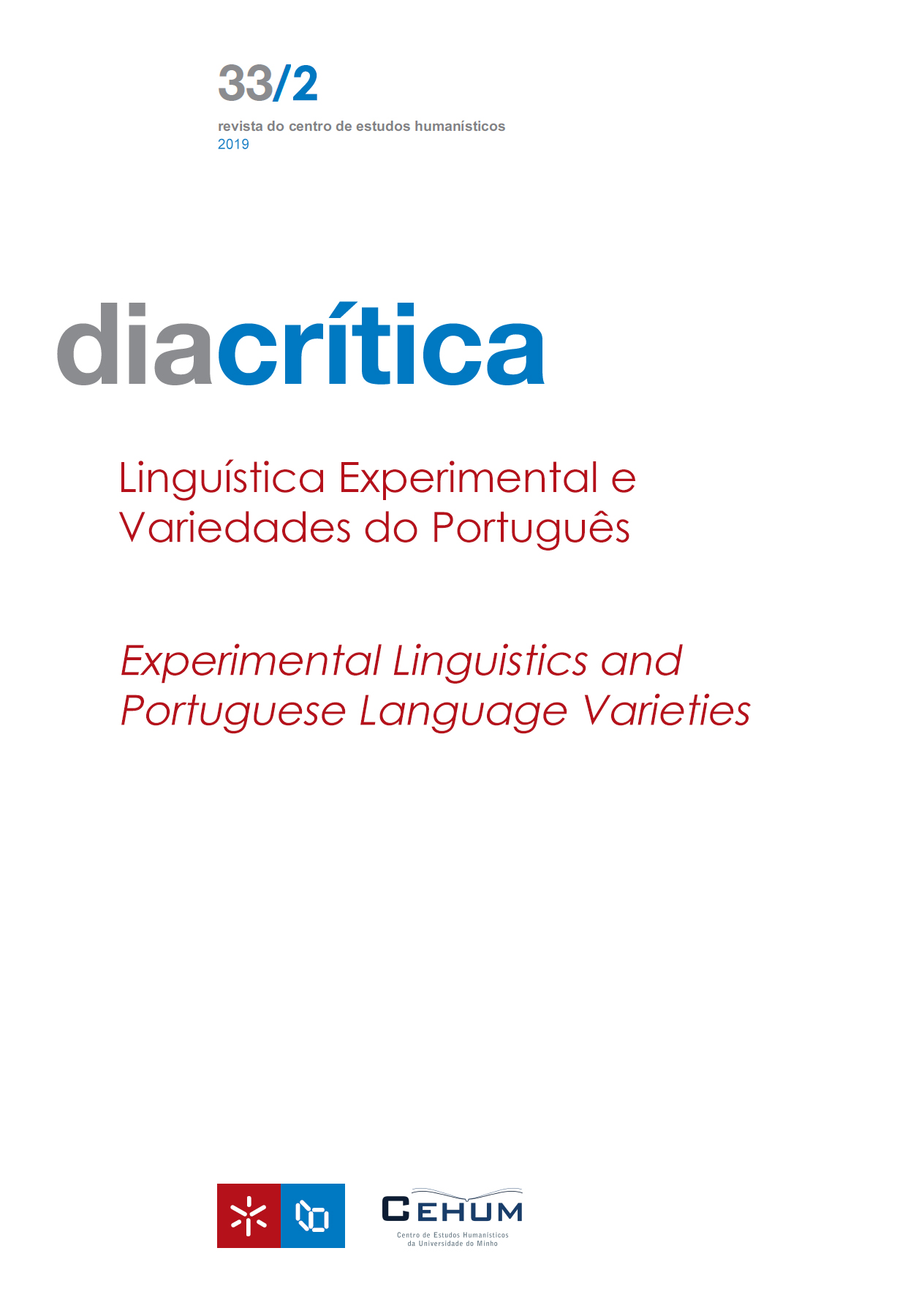Descrição e classificação sintática das expressões proverbiais do Português Europeu
DOI:
https://doi.org/10.21814/diacritica.5067Palavras-chave:
Provérbios, Classificação sintática, Português europeu, PLNResumo
Os provérbios são expressões de uso generalizado, utilizados em diferentes situações conversacionais e assumindo diferentes funções no discurso em que se integram. Do ponto de vista sintático, este tipo de expressões apresenta uma grande variedade de estruturas. Tendo isto em conta, o objetivo principal deste trabalho é estabelecer uma classificação formal sintática dos provérbios do português europeu. Para tal, pretendemos desenvolver e aprofundar a tipologia de classificação formal proposta por Rassi et al. (2014). Por conseguinte, será considerada uma subclassificação para as classes que apresentam um elevado número de provérbios e uma eventual reclassificação de alguns dos tipos. A proposta de classificação foi validada pela anotação independente por dois linguistas de uma lista de provérbios muito usuais, medindo-se depois o acordo entre anotadores, que foi muito elevado. Esta classificação, por sua vez, será o ponto de partida para o desenvolvimento de um procedimento de classificação automática deste tipo de estruturas, e contribuir assim para a elaboração de recursos para diferentes aplicações em Processamento da Linguagem Natural (PLN).
Referências
Bruckschen, M., Muniz F., Souza, J. G. C., Fuchs, J. T., Infante, K., Muniz, M., ...Aluísio, S.(2008). Anotação linguística em XML do Corpus PLN-BR. Série de Relatórios do NILC, NILC–NILC-TR-08-09.Universidade de São Paulo, Brasil.Disponível em: http://www.nilc.icmc.usp.br/nilc/index.php/publications#conference_papers
Chacoto, L. (1994). Estudo e formalização das propriedades léxico-sintácticas das expressões fixas proverbiais(Tese de mestrado, Faculdade de Letras da Universidade de Lisboa, Lisboa).
Chacoto, L. (2007). A sintaxe dos proverbios. As estruturas quem/quien en português e español. Cadernos de Fraseoloxía Galega,9, 31–53.
Chacoto, L. (2008). Vale mais um gosto na vida que três vinténs na algibeira -Las estructuras comparativas en los proverbios portugueses. In G. Conde Tarrío (Ed.),Aspectos formales y discursivos de las expresiones fijas(pp. 87–103).Frankfurt: Peter Lang.
Chacoto, L. (2010). Não há rifão velho, se é dito a propósito –La condición en los refranes portugueses. InJ.Korhonen, W. Mieder,E.Piirainen,&R. Piñel(Eds.), Actas do Congresso Internacional Europhras 2008(pp. 58–65). Universidade de Helsínquia, Finlândia.
Clark, A., Fox, C.&Lappin, S. (Eds.)(2010). The handbook of computational linguistics and natural language processing. New Jersey: Wiley-Blackwell. DOI: https://doi.org/10.1002/9781444324044
Costa, J. (1999). O Livro dos Provérbios Portugueses. Lisboa, Portugal: Editorial Presença.
Machado, J. (1996). O Grande Livro dos Provérbios(1ª ed.).Lisboa: Editorial Notícias.
Mateus, M. H. M., Brito, A. M., Duarte, I., Faria, I. H., Frota, S., Matos, G., ...Villalva, A.(2003). Gramática da Língua Portuguesa(5ª ed.revista e aumentada).Lisboa: Caminho.
Moreira, A. (1996). Provérbios Portugueses. Lisboa:Editorial Notícias.
Parente, S. (2005). O Livro dos Provérbios(1ª ed.).Lisboa: Editora Âncora.
Permjakov, G. L. (1973). On the paremiological level and premiological minimum of language. Proverbium, 22, 862–863.
Rassi, A., Baptista, J.&Vale, O. (2014). Automatic detection of proverbs and their variants. In M. J.Pereira, J.P.Leal&A.Simões(Eds.),3rdSymposium on Languages, Applications and Technologies (SLATE’14), (pp. 235–249). Leibniz: Dagstuhl Publishing.https://doi.org/10.4230/OASIcs.SLATE.2014.235
Reis, S.&Baptista, J. (2016a). Let’s play with proverbs? –NLP tools and resources for iCALL applications around proverbs for PFL. InProceedings of the International Congress on Interdisciplinarity in Social and Human Sciences, 5-6 maio (pp. 427–446). Faro: Universidade do Algarve.https://doi.org/10.13140/RG.2.1.1244.7603
Reis, S.&Baptista, J. (2016b). Portuguese Proverbs: Types andVariants. In G. C.Pastor(Ed.),Computorised and corpus-based approaches to phraseology: Monolingual and multilingual perspectives(pp. 208–2017). Geneve: Editions Tradulex.
Reis, S. & Baptista, J. (2017a). Estimating lexical availability of European Portuguese proverbs. In R. Mitkov(Ed.),Lecture Notes in Computer Science: Vol. 10596. Computational and corpus-based phraseology. EUROPHRAS 2017(pp. 232–244). Cham: Springer.https://doi.org/10.1007/978-3-319-69805-2_17 DOI: https://doi.org/10.1007/978-3-319-69805-2_17
Reis, S.&Baptista, J. (2017b). O uso de provérbios no ensino de português. In R. Soares & O. Lauhakangas (Eds.),10º Colóquio interdisciplinarsobre provérbios. Actas ICP16(pp. 521–538). Tavira, Portugal: AIP–IAP.
Reis, S.&Baptista, J. (2017c). Os provérbios em manuais de ensino de Português Língua Não Materna. In V.Pinheiro & G.H.Paetzold (Eds.),Jornadas de Descrição do Português, integradas noSTIL2017, 2–5 outubro (pp. 247–255). Uberlândia:Sociedade Brasileira de Computação.
Downloads
Publicado
Como Citar
Edição
Secção
Licença
Direitos de Autor (c) 2023 Sónia Reis, Jorge Baptista

Este trabalho encontra-se publicado com a Creative Commons Atribuição-NãoComercial 4.0.










